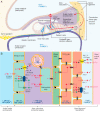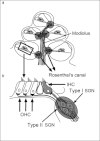Molecular biology of hearing
- PMID: 22558056
- PMCID: PMC3341583
- DOI: 10.3205/cto000079
Molecular biology of hearing
Abstract
THE INNER EAR IS OUR MOST SENSITIVE SENSORY ORGAN AND CAN BE SUBDIVIDED INTO THREE FUNCTIONAL UNITS: organ of Corti, stria vascularis and spiral ganglion. The appropriate stimulus for the organ of hearing is sound, which travels through the external auditory canal to the middle ear where it is transmitted to the inner ear. The inner ear houses the hair cells, the sensory cells of hearing. The inner hair cells are capable of mechanotransduction, the transformation of mechanical force into an electrical signal, which is the basic principle of hearing. The stria vascularis generates the endocochlear potential and maintains the ionic homeostasis of the endolymph. The dendrites of the spiral ganglion form synaptic contacts with the hair cells. The spiral ganglion is composed of neurons that transmit the electrical signals from the cochlea to the central nervous system. In recent years there has been significant progress in research on the molecular basis of hearing. An increasing number of genes and proteins related to hearing are being identified and characterized. The growing knowledge of these genes contributes not only to greater appreciation of the mechanism of hearing but also to a deeper understanding of the molecular basis of hereditary hearing loss. This basic research is a prerequisite for the development of molecular diagnostics and novel therapies for hearing loss.
Keywords: cochlea; deafness; hair cell; inner ear; organ of Corti; spiral ganglion.
Figures










Similar articles
-
[Molecular biology of hearing].Laryngorhinootologie. 2011 Mar;90 Suppl 1:S22-34. doi: 10.1055/s-0030-1270444. Epub 2011 Apr 26. Laryngorhinootologie. 2011. PMID: 21523631 Review. German.
-
Structure and innervation of the cochlea.Brain Res Bull. 2003 Jun 15;60(5-6):397-422. doi: 10.1016/s0361-9230(03)00047-9. Brain Res Bull. 2003. PMID: 12787864 Review.
-
Navigating Hereditary Hearing Loss: Pathology of the Inner Ear.Front Cell Neurosci. 2021 May 20;15:660812. doi: 10.3389/fncel.2021.660812. eCollection 2021. Front Cell Neurosci. 2021. PMID: 34093131 Free PMC article. Review.
-
[Regeneration of hair cells and auditory neurons in the ear].Bull Mem Acad R Med Belg. 2008;163(7-9):391-6; discussion 397. Bull Mem Acad R Med Belg. 2008. PMID: 19445109 French.
-
Expression of transient receptor potential channel mucolipin (TRPML) and polycystine (TRPP) in the mouse inner ear.Acta Otolaryngol. 2010 Feb;130(2):196-203. doi: 10.3109/00016480903013593. Acta Otolaryngol. 2010. PMID: 20095091
Cited by
-
High prevalence of CDH23 mutations in patients with congenital high-frequency sporadic or recessively inherited hearing loss.Orphanet J Rare Dis. 2015 May 13;10:60. doi: 10.1186/s13023-015-0276-z. Orphanet J Rare Dis. 2015. PMID: 25963016 Free PMC article.
-
MicroRNA profile of human endo-/perilymph.J Neurol. 2018 Oct;265(Suppl 1):26-28. doi: 10.1007/s00415-018-8862-3. Epub 2018 Apr 17. J Neurol. 2018. PMID: 29666983 No abstract available.
-
Identification and computational analysis of USH1C, and SLC26A4 variants in Pakistani families with prelingual hearing loss.Mol Biol Rep. 2020 Dec;47(12):9987-9993. doi: 10.1007/s11033-020-06016-y. Epub 2020 Nov 24. Mol Biol Rep. 2020. PMID: 33231815 Free PMC article.
-
Effects of electrode position on spatiotemporal auditory nerve fiber responses: a 3D computational model study.Comput Math Methods Med. 2015;2015:934382. doi: 10.1155/2015/934382. Epub 2015 Feb 10. Comput Math Methods Med. 2015. PMID: 25755675 Free PMC article.
-
What is the safe noise exposure level to prevent noise-induced hearing loss?J Expo Sci Environ Epidemiol. 2025 Jan;35(1):124-128. doi: 10.1038/s41370-024-00660-3. Epub 2024 Apr 18. J Expo Sci Environ Epidemiol. 2025. PMID: 38637639 Free PMC article. No abstract available.
References
-
- Santi PA, Tsuprun VL. Cochlear microanatomy and ultrastructure. In: Jahn AF, Santos-Sacchi J, editors. Physiology of the Ear. San Diego, CA: Singular Publishing; 2001.
-
- Slepecky NB. Cochlear structure. In: Dallos P, Popper AN, Fay R, editors. The Cochlea. New York: Springer; 1996. pp. 44–129. Available from: http://dx.doi.org/10.1007/978-1-4612-0757-3_2. - DOI - DOI
-
- Boenninghaus, Lenarz . Innenohr (Labyrinth) In: Boenninghaus, Lenarz, editors. HNO. Springer Medizin Verlag; 2007. pp. 15–19.
-
- Starlinger V, Masaki K, Heller S. Auditory physiology: Inner ear. In: Gulya AJ, Minor LB, Poe DS, editors. Glasscock-Shambaugh's Surgery of the Ear. 6th ed. People's Medical Publishing House; 2010. pp. 73–83.
-
- Rhys Evans PH, Comis SD, Osborne MP, Pickles JO, Jeffries DJ. Cross-links between stereocilia in the human organ of Corti. J Laryngol Otol. 1985;99:11–19. doi: 10.1017/S0022215100096237. Available from: http://dx.doi.org/10.1017/S0022215100096237. - DOI - DOI - PubMed
LinkOut - more resources
Full Text Sources

